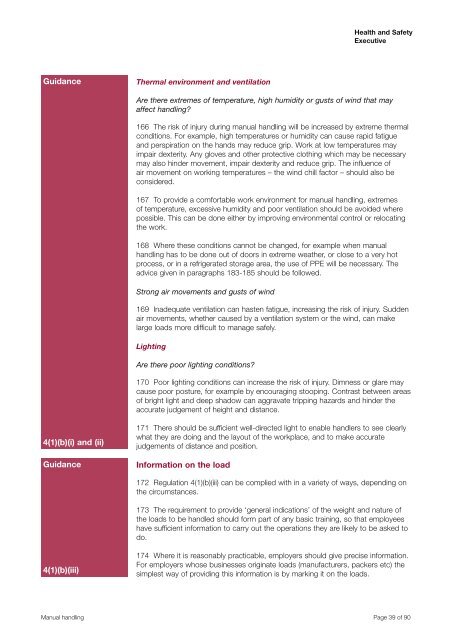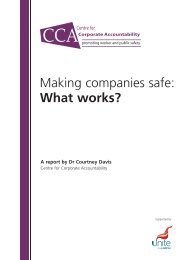Manual Handling Manual Handling Operations Regulations 1992 ...
Manual Handling Manual Handling Operations Regulations 1992 ...
Manual Handling Manual Handling Operations Regulations 1992 ...
Create successful ePaper yourself
Turn your PDF publications into a flip-book with our unique Google optimized e-Paper software.
Health and Safety<br />
Executive<br />
Guidance<br />
Thermal environment and ventilation<br />
Are there extremes of temperature, high humidity or gusts of wind that may<br />
affect handling?<br />
166 The risk of injury during manual handling will be increased by extreme thermal<br />
conditions. For example, high temperatures or humidity can cause rapid fatigue<br />
and perspiration on the hands may reduce grip. Work at low temperatures may<br />
impair dexterity. Any gloves and other protective clothing which may be necessary<br />
may also hinder movement, impair dexterity and reduce grip. The influence of<br />
air movement on working temperatures – the wind chill factor – should also be<br />
considered.<br />
167 To provide a comfortable work environment for manual handling, extremes<br />
of temperature, excessive humidity and poor ventilation should be avoided where<br />
possible. This can be done either by improving environmental control or relocating<br />
the work.<br />
168 Where these conditions cannot be changed, for example when manual<br />
handling has to be done out of doors in extreme weather, or close to a very hot<br />
process, or in a refrigerated storage area, the use of PPE will be necessary. The<br />
advice given in paragraphs 183-185 should be followed.<br />
Strong air movements and gusts of wind<br />
169 Inadequate ventilation can hasten fatigue, increasing the risk of injury. Sudden<br />
air movements, whether caused by a ventilation system or the wind, can make<br />
large loads more difficult to manage safely.<br />
Lighting<br />
Are there poor lighting conditions?<br />
170 Poor lighting conditions can increase the risk of injury. Dimness or glare may<br />
cause poor posture, for example by encouraging stooping. Contrast between areas<br />
of bright light and deep shadow can aggravate tripping hazards and hinder the<br />
accurate judgement of height and distance.<br />
4(1)(b)(i) and (ii)<br />
Guidance<br />
171 There should be sufficient well-directed light to enable handlers to see clearly<br />
what they are doing and the layout of the workplace, and to make accurate<br />
judgements of distance and position.<br />
Information on the load<br />
172 Regulation 4(1)(b)(iii) can be complied with in a variety of ways, depending on<br />
the circumstances.<br />
173 The requirement to provide ‘general indications’ of the weight and nature of<br />
the loads to be handled should form part of any basic training, so that employees<br />
have sufficient information to carry out the operations they are likely to be asked to<br />
do.<br />
4(1)(b)(iii)<br />
174 Where it is reasonably practicable, employers should give precise information.<br />
For employers whose businesses originate loads (manufacturers, packers etc) the<br />
simplest way of providing this information is by marking it on the loads.<br />
<strong>Manual</strong> handling Page 39 of 90
















